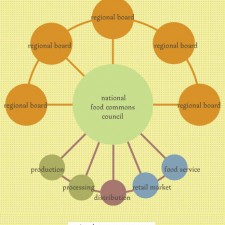 An essential goal of the Food Commons model is to achieve a more democratic and cooperative food system with greater alignment and accountability to the communities served and greater equity and fairness for all participants. Manifesting this vision will require new organizational structures that are grounded in Food Commons principles and that draw on the best elements of co-operative, public utility, trust and corporate governance models.
An essential goal of the Food Commons model is to achieve a more democratic and cooperative food system with greater alignment and accountability to the communities served and greater equity and fairness for all participants. Manifesting this vision will require new organizational structures that are grounded in Food Commons principles and that draw on the best elements of co-operative, public utility, trust and corporate governance models.
Two of the core principles the Food Commons governance structure will be responsible for upholding are:
- Preservation of common benefit along the value chain. The governing boards of entities within the Food Commons system will be tasked with attempting to balance the needs of the whole system, from the environment, to workers, to farmers and fishers, to aggregators/processors, to retailers, and to consumers.
- Sustainable, steady-state profitability. The governing boards will establish goals, incentive structures, and checks and balances that drive efficient use of resources and sustainable positive economic value creation, not unlimited growth and maximization of shareholder profit at the expense of other stakeholders, including future generations.
The integrated governing body at the regional level would be a Regional Coordinating Council comprised of representatives from each of the three Food Commons components (Trust, CDFI and Hub) plus representatives from each of the key sectors in the food system. Also, several seats would be allocated to representatives-at-large who might be retired industry people, or disinterested experts who have no economic interest in the decisions made by the Board. Labor representation would be fully integrated at all governance levels.
Each Regional Coordinating Council would have subcommittees for each of the three Food Commons components, allowing for focused decision-making while at the same time assuring that the governance of the region would be integrated.
The Regional Coordinating Council sets the direction and vision for the local Food Commons and develops policy in concert with the national Food Commons nonprofit board. It would oversee negotiations between different levels of the value chain, and serve as arbiter when necessary.
 Regional Boards would be linked together through a central federated governance system, but would operate fairly autonomously within their respective regions. At the national level, the Food Commons nonprofit board would be comprised of representatives from each of the Regional Boards as well as representatives from the different food system sectors. The Food Commons nonprofit board would be responsible for national level decisions regarding direction, coordination, support, and advocacy.
Regional Boards would be linked together through a central federated governance system, but would operate fairly autonomously within their respective regions. At the national level, the Food Commons nonprofit board would be comprised of representatives from each of the Regional Boards as well as representatives from the different food system sectors. The Food Commons nonprofit board would be responsible for national level decisions regarding direction, coordination, support, and advocacy.
The goal of the governance structure would be to ensure accountability, economic viability and social balance.
The goal of the governance structure would be to ensure accountability, economic viability and social balance. Principles of democratic governance and public accountability would be included in organizational documents, articles of incorporation, and by-laws. All Board members would be held accountable to these principles, including legal requirements to balance interests among different constituencies across the value chain.
